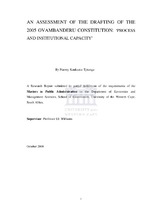| dc.description.abstract | This research report sets up a model of policy development at Traditional Authority level in Namibia that is then used in examining the Ovambanderu constitutional case. Reference to the Generic Model, as used by de Coning (2000) and the Moore (1995) Strategic Triangle is not new or original to this thesis. These models have been used elsewhere and were considered as appropriate for this case study due to the complexity of the issues under consideration. This study attempts to demonstrate the importance of applying public policy models and theories to policy making in Namibia. Firstly, the author has applied the generic model to the Ovambanderu case to elicit information pertaining to the process followed in drafting the constitution. Secondly, the Moore Strategic Triangle was used in furthering discussion on the importance of considering phases and stages in the public policy process, which touch on such aspects as political feasibility, substantive value and administrative feasibility (Moore, 1995). The emphasis here was on the importance of dynamism in the policy-making process, not as a once off
event but as an ongoing process. This research report shows that public policy/constitution making needs specialised skills in order for it to be a success. Capacity needs to be sourced and used appropriately, while objectives of the policy/constitution are communicated clearly to the stakeholders. Again the fear amongst the community that once a policy/constitution is implemented it becomes binding and difficult to change needs to be addressed by clearly informing people that a policy remains a statement of intent until it is put to use and once it is implemented there is always room for improvement on issues that may create problems for the affected parties. Another important lesson is the fact that public policy making has been and remains a process as it involves bargaining, issue prioritisation, issue filtration, advocacy, reporting and consultation before decisions are made. The Ovambanderu constitutional problem has now set a scene for better policy planning at Traditional Authority level and the government needs to consider this as a serious phenomenon that can lead to major problems if ignored | en_US |

